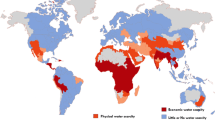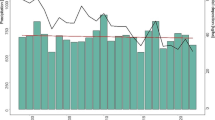Abstract
Water supply in Australia mainly relies on precipitation and, therefore, is highly dependent on climate variability and change. Coupled with reduced rainfall reliability, population and economic growth and increasing competition for water resources augment the concern over the existing water resources and put a strain on future water security. In fact, the upward trend of water demand has already been escalating the pressure on water resources. Clearly, the anticipation of decline in water supply requires the identification of more reliable, rainfall-independent supply alternatives. With this in mind, this paper discusses the role and value of desalination in water grids. For this purpose, we present a modelling framework using System Dynamics approach to incorporate a range of factors into a simulation of future water demand and supply in Queensland, Australia; and examine desalination schemes as long-term water security option in the portfolio of supply sources. In particular, the model is used to explore the sensitivity of long term planning of water resources with respect to two specific assumptions, the discount rate and the degree of water security. The proposed approach would help decision makers to develop sustainable water supply and efficient infrastructure strategies, and thus respond to water scarcity in a timely manner.









Similar content being viewed by others
References
ABS (2010) Measures of Australia's Progress. Australian Bureau of Statistics. http://www.abs.gov.au/ausstats/abs@.nsf/Lookup/by%20Subject/1370.0~2010~Chapter~Water%20storage%20(6.3.6.2). Accessed February 2013
ABS (2012) 2012 Year Book Australia vol ABS Catalogue No. 1301.0. The Australian Bureau of Statistics, Canberra, Australia
Beal C, Stewart RA (2011) South East Queensland Residential End Use Study: Final Report. Gold Coast, Australia
BOM (2013) Water storage. Commonwealth of Australia 2012, Bureau of Meteorology. http://water.bom.gov.au/waterstorage/awris/. Accessed January 2013
Borshchev A, Filippov A From System Dynamics and Discrete Event to Practical Agent Based Modelling: Reasons, Techniques, Tools. In: The 22nd International Conference of the System Dynamics Society, Oxford 2004.
Britton TC, Stewart RA, O'Halloran KR (2013) Smart metering: enabler for rapid and effective post meter leakage identification and water loss management J Clean Prod 54:166–176 doi:10.1016/j.jclepro.2013.05.018
Burton I, Huq S, Lim B, Pilifosova O, Schipper EL (2002) From Impacts Assessment to Adaptation Priorities: the Shaping of Adaptation Policy Climate Policy 2:145–159
Cavana RY, Clifford LV (2006) Demonstrating the utility of system dynamics for public policy analysis in New Zealand: the case of excise tax policy on tobacco. Syst Dynam Rev 22:321–348
Fiddaman T (1997) Feedback Complexity in Integrated Climate-Economy Models. Technology, Massachusetts Institute of
Fiddaman TS (2002) Exploring policy options with a behavioral climate-economy model Syst Dynam Rev 18:243–267 doi: 10.1002/Sdr.241
Fielding KS, Spinks A, Russell S, McCrea R, Stewart R, Gardner J (2013) An experimental test of voluntary strategies to promote urban water demand management Journal of Environmental Management 114:343–351 doi:DOI 10.1016/j.jenvman.2012.10.027
Ford A (2005) Simulating the impacts of a strategic fuels reserve in California. Energ Policy 33:483–498
Forrester JW (1961) Industrial dynamics. (Students' edition) edn. MIT Press, Cambridge, Mass
Franck TR (2009) Coastal Communities and Climate Change" A Dynamic Model of Risk Perception. Storms and Adaptation, Massachusetts Institute of Technology
Gharib S (2008) Synthesizing System Dynamics and Geographic Information Systems in a new method to Model and Simulate Environmental Systems. University of, Bergen
Girard M, Stewart RA (2007) Implementation of pressure and leakage management strategies on the Gold Coast, Australia: Case study Journal of Water Resources Planning and Management 133:210–217 doi: 10.1061/(Asce)0733-9496(2007)133:3(210)
Gurung TR, Sharma A (2014) Communal rainwater tank systems design and economies of scale J Clean Prod 67:26–36 doi: http://dx.doi.org/10.1016/j.jclepro.2013.12.020
Harrison M (2010) Valuing the future : the social discount rate in cost-benefit analysis : visiting research paper. Australia Productivity Commission Visiting Researcher Paper, vol (April 2010). Productivity Commission, Melbourne
Hennessy K et al. (2007) Australia and New Zealand.
Homer J, Hirsch G, Minniti M, Pierson M (2004) Models for collaboration: how system dynamics helped a community organize cost-effective care for chronic illness Syst Dynam Rev 20:199–222 doi: 10.1002/Sdr.295
Homer J, Hirsch G, Milstein B (2007) Chronic illness in a complex health economy: the perils and promises of downstream and upstream reforms Syst Dynam Rev 23:313–343 doi: 10.1002/Sdr.379
Loucks DP, van Beek E (2005) Water resources systems planning and management : an introduction to methods, models and applications. Studies and reports in hydrology / Unesco Publishing, Unesco, Paris
Marchand M (2009) Modelling coastal vulnerability : design and evaluation of a vulnerability model for tropical storms and floods. Deltares select series,, vol 05. IOS Press, Amsterdam
Marsden J, Pickering P (2006) Securing Australia's urban water supplies opportunities and impediments
Moran A (2008) Water supply options for Melbourne - An examination of costs and availabilities of new water supply sources for Melbourne and other urban areas in Victoria. Institute of Public Affairs, Melbourne, Australia
NCEDA (2010) Australian desalination research roadmap. National Centre of Excellence in Desalination. Murdoch University, Rockingham, Western Australia
NWC (2006) Australia’s water supply status and seasonal outlook
Pereira LS, Cordery I, Iacovides I (2009) Coping with Water Scarcity - Addressing the Challenges. Springer, Dordrecht. doi:10.1007/978-1-4020-9579-5 5
Queensland Treasury (2011) Population projections to 2031: local government areas, 2011 edn.,
Queensland Office of Economic and Statistical Research (2011) Local government areas : Queensland Government population projections to 2031. 2011. Office of Economic and Statistical Research, City East, Qld
QWC (2010) South East Queensland water strategy. Queensland Water Commission, City East, Qld
QWC (2012) South East Queensland Water Strategy - Annual Report 2012. Queensland Water Commission, City East, Qld
Roberts N (1983) Introduction to computer simulation : the system dynamics approach. Addison-Wesley, Reading, Mass
Sahin O (2011) Dynamic Assessment of Coastal Vulnerability and Adaptation to Sea Level Rise: An Integrated Spatial-Temporal Decision Making Approach. University, Griffith
Sahin O, Mohamed, S., (2013) A spatial temporal decision framework for adaptation to sea level rise Environ Modell Softw In Press
Sahin O, Mohamed S Decision dilemmas for adaptation to sea level rise: How to, when to? In: Industrial Engineering and Engineering Management, 2009. IEEM 2009. IEEE International Conference on, 8–11 Dec. 2009 2009. pp 1622–1626
Sterman JD (2008) Economics - Risk communication on climate: Mental models and mass balance Science 322:532–533 doi: 10.1126/science.1162574
Stewart R (2011) Verifying the end use potable water savings from contemporary residential water supply schemes. National Water Commission Waterlines Report No. 61, Australian Government, Canberra
Stewart RA, Willis RM, Panuwatwanich K, Sahin O (2011) Showering behavioural response to alarming visual display monitors: longitudinal mixed method study Behaviour & Information Technology:1–17 doi:10.1080/0144929x.2011.577195
Ventana Systems (2012) Vensim DSS, 6.0b edn. Ventana Systems, Inc., Harvard, MA
Vieira AS, Beal CD, Ghisi E, Stewart RA (2014) Energy intensity of rainwater harvesting systems: A review Renew Sust Energ Rev 34:225–242 doi: 10.1016/j.rser.2014.03.012
Wasimi SA (2010) Planning for a Large Dam Project: The Case of Traveston Crossing Dam Water Resources Management 24:2991–3015 doi: 10.1007/s11269-010-9591-2
Weitzman ML (1998) Why the far-distant future should be discounted at its lowest possible rate. J Environ Econ Manag 36:201–208
Weitzman ML (2013) Tail-Hedge Discounting and the Social Cost of Carbon. J Econ Lit 51:873–882. doi:10.1257/jel.51.3.873
Willis R, Stewart R, Panuwatwanich K, Jones K, Kyriakides A (2010) Alarming visual display monitors affecting shower end use water and energy conservation in Australian residential households Resources. Conserv Recycl 54:1117–1127
Willis RM, Stewart RA, Panuwatwanich K, Williams PR, Hollingsworth AL (2011a) Quantifying the influence of environmental and water conservation attitudes on household end use water consumption Journal of Environmental Management 92:1996–2009 doi: 10.1016/j.jenvman.2011.03.023
Willis RM, Stewart RA, Williams PR, Hacker CH, Emmonds SC, Capati G (2011b) Residential potable and recycled water end uses in a dual reticulated supply system Desalination 272:201–211 doi: 10.1016/j.desal.2011.01.022
Willis RM, Stewart RA, Giurco DP, Talebpour MR, Mousavinejad A (2013) End use water consumption in households: impact of socio-demographic factors and efficient devices J Clean Prod 60:107–115 doi:http://dx.doi.org/10.1016/j.jclepro.2011.08.006
Zhang B (2008) A Study of GIS-SD Based Temporal-Spatial Modelling Of Water Quality In Water Pollution Accidents. Paper presented at the ISPRS Congress Beijing 2008, Proceedings of Commission II, Beijing
Acknowledgment
This research, is part of a study on desalinated water in Australian bulk water supply networks, funded by a grant from the National Centre of Excellence in Desalination Australia (NCEDA) to the Alfred Deakin Research Institute (ADRI) at Deakin University, in a project jointly managed with the Smart Water Research Centre at Griffith University, and with technical cooperation from AECOM Ltd.
The authors gratefully acknowledge the travel funding from the Griffith Climate Change Response Program (GCCRP).
Author information
Authors and Affiliations
Corresponding author
Rights and permissions
About this article
Cite this article
Sahin, O., Stewart, R.A. & Helfer, F. Bridging the Water Supply–demand Gap in Australia: Coupling Water Demand Efficiency with Rain-independent Desalination Supply. Water Resour Manage 29, 253–272 (2015). https://doi.org/10.1007/s11269-014-0794-9
Received:
Accepted:
Published:
Issue Date:
DOI: https://doi.org/10.1007/s11269-014-0794-9




